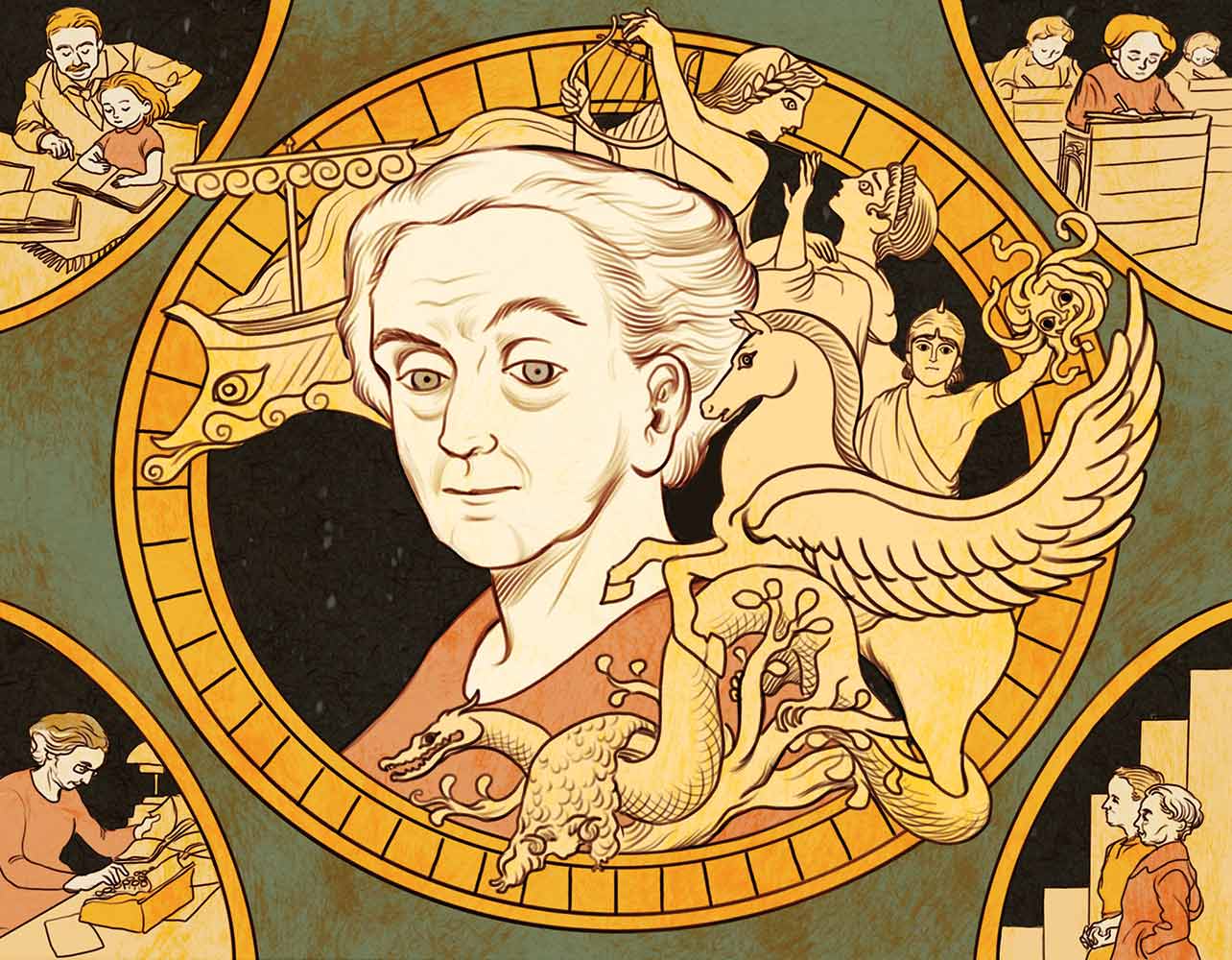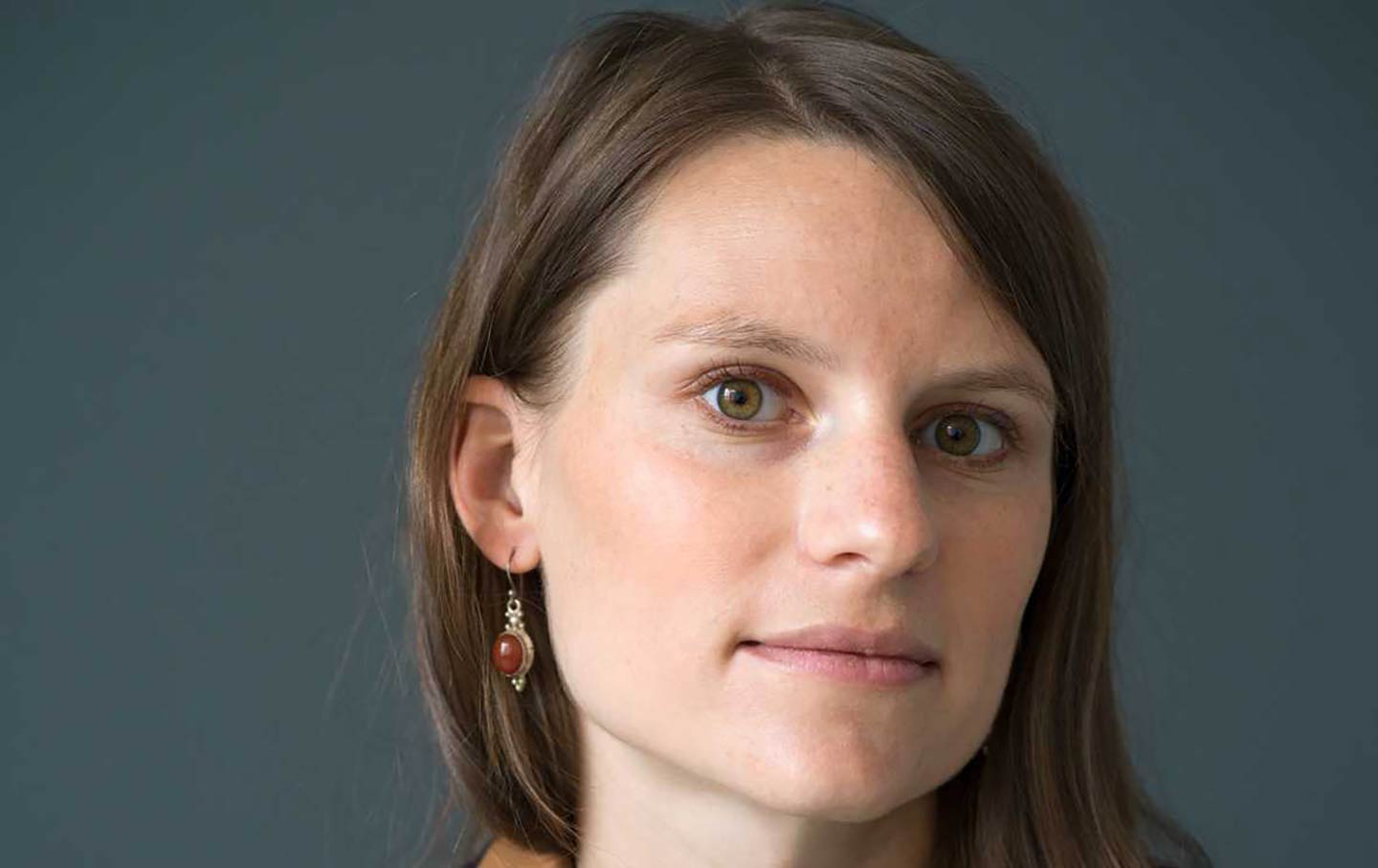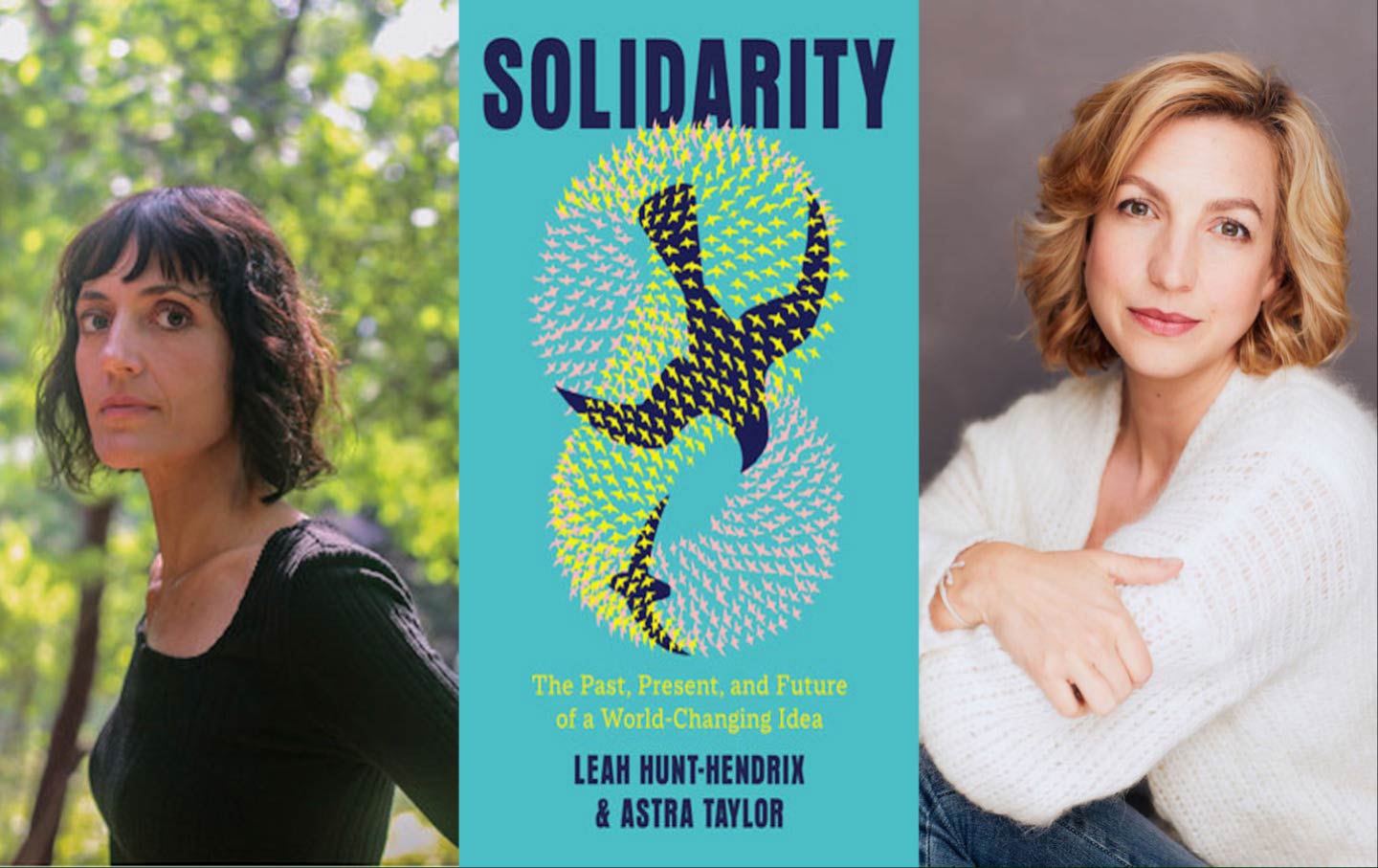Ancient Worlds
Edith Hamilton and the popularization of the classics.
The Latin School Teacher Who Made Classics Popular
A new biography of Edith Hamilton tells the story of how and why ancient literature became widely read in the United States.

The discipline of “classical” literature has long been associated with social gatekeeping. The mastery of Latin and ancient Greek—or at least enough of an acquaintance to be able to trot out a well-worn tag from Horace and prompt knowing chuckles over the brandy—has often provided a useful qualification for passing as a gentleman and keeping out the plebs (Latin for “common people”) or hoi polloi (ancient Greek for “the many”). It is understandable that George Eliot’s Maggie Tulliver eagerly whizzes through the Latin textbooks neglected by her idle brother Tom, or that Thomas Hardy’s Jude, hoping in vain to escape the obscurity of provincial poverty, slogs through his Greek dictionary until late into the night. For these fictional characters, like many of their real-life equivalents, ancient languages and literature provided the most visible bar against entry into a “higher” social class.
Books in review
American Classicist: The Life and Loves of Edith Hamilton
Buy this bookEven in the 20th and 21st centuries, the subject has maintained a close association with systems of exclusion based on income, education, race, and gender. In the United Kingdom, its cultural capital remains high enough that Boris Johnson—a bafflingly incompetent drunkard—managed to hold on to the highest political office in the land for an astonishingly long period of time and even maintained a reputation as something of an intellectual (sic—from the Latin phrase sic erat scriptum, “thus it had been written,” usually expressing astonished disbelief) on the basis of his ability to parrot a few garbled lines of Homeric Greek. No other party trick could have served him as well. Thanks to centuries of culturally ingrained snobbery, the acquisition of these languages is still often considered a sign of extraordinary intelligence—as if it were really any harder to learn ancient Greek than it is to learn plumbing, Arabic, or mechanical engineering.
Over the past century, there have been numerous attempts to provide wider access to the supposed treasures of Greek and Roman antiquity to those once excluded from its riches. In the early 20th century, translations of ancient texts became more widely available, ranging from Gilbert Murray’s wonderfully ornate and virtuosic renditions of Euripides to Hilda Doolittle’s much starker modernist free verse. The Loeb Classical Library was founded in 1911 and featured fairly inexpensive editions of these ancient texts in their original languages, with an English translation on the facing page. These translations heralded a new age in which once-inaccessible works of classical literature became more accessible to a far wider range of people. As Virginia Woolf noted in 1917, it was the Loeb Library editions that helped make it “respectable” for the “amateur” (including female ones) to muddle through Aeschylus.
After the First World War, an ever-larger number of colleges and universities in the United States began to offer classes on ancient texts studied in translation, with no expectation that students would be able to read even a little of the originals. By the early 20th century, the study of ancient literature and history was often considered a prerequisite for understanding contemporary issues in Europe and the United States—regions that were now often lumped together under the term “the West.” The Columbia Core, the first such course in the United States, was developed in 1919 with the explicit goal of showing students the “unique features of the western world,” a world that apparently had begun in ancient Greece and that had now reached its apex in the American present.
The goal of connecting US citizens to a long, largely fabricated notion of “Western civilization” seemed increasingly urgent in the aftermath of a war that had torn the nations of Europe apart. The fantasy of a common “Western” heritage shared by white Europeans and North Americans appeared as a prophylactic against future wars, at least between those who could qualify as “Westerners.” But it also did something else. By excluding the numerous surviving ancient texts and cultural artifacts from the rest of the world, these new courses on “Western civilization” suggested that premodern “civilization” was the exclusive property of the “West”—enabling a kind of mythical/historical justification for continued domination of those peoples deemed to have come from outside this exclusive group, whether it was Black and Asian Americans in the United States or the millions still living under imperial and colonial rule in Asia and Africa.
By the 1920s, a sizable market for popular classics books and translations had emerged in the United States. A new publishing firm, W.W. Norton, decided to seize on it and signed up a recently retired Latin teacher and private school headmistress named Edith Hamilton to translate a trio of Greek tragedies and write two surveys of ancient literature, The Greek Way and The Roman Way. Published in quick succession in the 1930s, these volumes proved to be an immediate success. Along with Mythology, her retelling of the Greco-Roman legends, the books made Hamilton a household name. Mythology has never been out of print since then and has remained an extraordinary commercial success, enriching her heirs and publishers to this day. Probably no other single person has had such an impact in shaping the perceptions of classical literature and mythology in the United States for almost a century.
How did a retired Latin schoolteacher (Hamilton was 62 when The Greek Way was published), with limited formal education and almost no scholarly credentials, come to be one of the most influential “classicists” of the 20th century? Victoria Houseman’s annalistic new biography, American Classicist, does not quite see this question as the puzzle it is, in part because Houseman has so much admiration for her subject that Hamilton’s successes are largely taken for granted. But the book still makes for gripping reading, as we trace the trajectory of Hamilton’s life from her activist youth (she was a member of the Baltimore Equal Suffrage League), through her various travels in Europe and Asia, her health troubles (she was a breast cancer survivor), her fascinating romantic partnerships with other women, to her second career as a popularizer of the ancient world and as a public intellectual who became closely associated with wealthy and powerful conservative groups in the US.
Edith Hamilton was born in 1867. She was the eldest in a family of four daughters and one son, the youngest, who was always known as Quintus—a mild joke (quintus is the Latin for “fifth”) that hints at the family’s educational aspirations. Hamilton was born in Germany, outside Dresden; her father, Montgomery Hamilton, had fought on the Union side in the Civil War and had traveled abroad to recuperate from an injury. There he met Hamilton’s mother, Gertrude Pond, whose wealthy, Southern-sympathizing, slavery-enriched family was managing its sugar business from Europe during the conflict.
The family moved back to the United States when Edith was 2 months old, and she grew up on her father’s homestead in Fort Wayne, Ind. Montgomery was a heavy drinker who proved unsuccessful in running his family’s business, but he was eager to educate his children, including the daughters: All were homeschooled, and Edith began learning Latin and ancient Greek from her father as a child. At 16, she was sent to a finishing school in Connecticut. She spent another few years at home in Indiana, waiting for her family to rustle up the money for college and filling in the gaps in her mathematical and linguistic preparation. She eventually passed the entrance exams at the recently founded Bryn Mawr College and performed well enough to acquire an AB and an MA, with a focus on the Latin of Seneca, in just over three years.
Three years of study is not generally considered adequate academic training for a scholar of the classics or, for that matter, of any other serious academic field. For a few years, Hamilton had dreams of acquiring a doctorate and becoming a professor. But it seems clear that she was not a natural philologist. She was terrified of the Greek professor at Bryn Mawr, Paul Shorey, and there is little evidence that her Greek was ever strong. Her graduate thesis focused on Seneca’s prose, but she was apparently not much interested in the topic. Throughout her life, she had an extraordinarily strong work ethic and fluency as a writer, but laboring over footnotes was not her forte.
After graduation, Hamilton was appointed as headmistress of the newly established Bryn Mawr School for Girls in Baltimore. She accepted the job reluctantly but nonetheless remained for almost 30 years, from 1896 to 1922. Her success as a headmistress speaks to her enormous talents as a visionary leader, administrator, and networker. Hamilton was able to fuse her passion for educating girls in Greek and Latin with ideas of “individual self-realization” borrowed from John Dewey, whom she met in 1898.
The wealthy families of Baltimore bought what Hamilton was selling, and the school became a major economic and social success. On one level, it opened the gates of classical learning to a social group—wealthy white girls—who had previously been shut out of the joys of Greek and Latin; but on another level, the social barriers of wealth and race were very much reinforced. The students were all white, and Jewish girls were not made welcome at the school, although Hamilton herself did not object to hiring Jewish teachers. As well as serving as the headmistress and guiding light for the school’s pedagogical mission, Hamilton taught in the classroom throughout her time there and marched the upper-level Latin class through sections of Virgil’s Aeneid every year.
In Baltimore, Hamilton became involved in the most elite (or, as Houseman terms it, “moderate”) form of women’s suffrage, advocating for voting rights only for educated women (i.e., not for those who were too poor or too Black to have had access to a school like Bryn Mawr). She also had a romantic interest in these years, a college friend and instructor at their alma mater named Lucy Martin Donnelly, who shared her devotion to classical literature and many of her cultural interests. Donnelly had affairs with various people during this period (including the philosopher Bertrand Russell), but she and Hamilton shared an intimate 15-year relationship, traveling together and supporting each other through periods of mental and physical illness.
In 1922, Hamilton retired from the Bryn Mawr School and also broke up with Donnelly. She had quarreled with M. Carey Thomas, the president of Bryn Mawr College and a prominent figure on the school board, in the wake of her resignation and felt that Donnelly had sided with Thomas. After their breakup, Hamilton barely spoke to Donnelly again, beyond a brief condolence card when her father died. But there were other reasons too. She had begun to develop a relationship with a woman named Doris Reid, who became Hamilton’s lifelong partner and cheerleader for her work, while also building her own career as a stockbroker, at a time when very few women participated in the field of finance.
Reid was the daughter of a Johns Hopkins geology professor and his wife, also named Edith. (Oddly, Houseman refers to her female subjects by their first names, which can lead to some confusion, though the men are mostly referred to by their last names.) Extraordinarily enough, the first time Hamilton and Reid met, Hamilton was 29 years old and Reid was less than 2 years old—a detail that seems straight out of Tina Fey’s classic Saturday Night Live sketch “Meet Your Second Wife.” Only months after her departure from Bryn Mawr and her breakup with Donnelly, Hamilton adopted a son with Reid: Dorian, one of Reid’s many nephews. Soon after that, the couple and little Dorian moved to New York City as a family.
The big city opened up new opportunities for Hamilton. She ascribed the start of her writing career to a friendship with yet another Edith, Edith J.R. Isaacs, a neighbor and friend who edited Theatre Arts Monthly and encouraged her to write the essays that became The Greek Way. But many others soon came knocking at Hamilton’s door as well, including Elling Aannestad, an editorial assistant at W.W. Norton, the publisher that would acquire The Greek Way, The Roman Way, and Hamilton’s translations of Aeschylus’s Agamemnon, the perhaps-Aeschylean Prometheus Bound, and Euripides’s Trojan Women. The choice of plays reflects Hamilton’s rather conventional perception of Greek tragedy as a genre focused on noble suffering: Greek tragedies with happy endings and little wailing—such as Euripides’s Helen or Ion—were of less interest to her. The Norton books soon caught the attention of other publishers, and at the prompting of C. Raymond Everitt, an editor at Little, Brown, Hamilton began working on Mythology, which became her greatest commercial triumph.
Popular
“swipe left below to view more authors”Swipe →While we are told a considerable amount about Hamilton’s emergence as a writer during her years in New York, her romantic and sexual life receives frustratingly short shrift in Houseman’s book. Houseman insists that Hamilton’s relationship with Donnelly “was likely not physically intimate,” on the very meager grounds that Hamilton told her sister they slept in separate bedrooms. We also learn very little about lesbian culture in the era more generally. Hamilton’s relationships with both Donnelly and Reid were in the mold of what was sometimes called a “Boston marriage” or “Wellesley marriage”; there were plenty of other lesbian relationships publicly recognized among highly educated New England women of the early 20th century.
Numerous passages of Mythology also read quite differently if we remember that the author was a lesbian rather than simply a heterosexual woman inhabiting a heteronormative male gaze: Consider, for instance, this exciting account of Atalanta stripping off her clothes for a sprint and looking “a hundredfold more lovely disrobed than with her garments on.” There is another, quite different biography of Hamilton waiting to be written, which would dig into the presumably complex relationship between her homosexuality and her fixation on a romanticized, very male-dominated image of ancient Greece—a vision partly shared by other prominent lesbian classicists of her generation, such as Mary Renault.
Focused primarily on Hamilton’s life, Houseman’s biography offers its readers very little on the crucial question of how Hamilton’s popular, often wildly inaccurate accounts of the ancient world were received by actual classical scholars of the mid-20th century. It would have been useful, for example, to contextualize her work more precisely alongside that of other teachers, translators, and scholars of her era. Hamilton’s idealizing vision of liberated and enlightened ancient Greece is starkly at odds with the vision of E.R. Dodds’s The Greeks and the Irrational. Homeric scholarship in the early 20th century—thanks to the labors of Milman Parry and his students and son—had also made enormous progress in understanding how archaic Greek oral poetics developed over many generations of folk tradition; Hamilton’s account of the Homeric poems and Greek myth seems entirely innocent of these new scholarly frameworks.
Hamilton’s most important influences were not contemporary 20th-century classics scholars but rather grand old men of the Victorian age, such as the Scottish idealist philosopher Edward Caird and the American educational reformer John Dewey. From this hodgepodge of sources, Hamilton drew a largely imaginary portrait of ancient Greece as the birthplace of “individualism,” “democracy,” and “the West”—in other words, as the precursor to a privileged white person’s idealized notion of America. Hamilton hardly ever provides any caveats to the notions of ancient Greek “freedom” and “democracy” (such as the fact that the vast majority of the population of ancient Athens was disenfranchised, and a great many people were enslaved).
Perhaps relatedly, Hamilton appears to have expressed very little interest in the civil rights movements of her time. She and Reid moved to Washington, D.C., in 1943, and their social circle seemed to move increasingly to the right. Reid became active in conservative politics, adopting positions that might now be seen as libertarian: She favored American isolationism and was obsessively anti-communist. Of course, none of these views are explicitly stated in Hamilton’s books, but they can be glimpsed in her account of ancient Greece as a magical land of democratic freedom, free from the taint of tyranny that, according to Hamilton, afflicted other ancient and modern societies.
Hamilton was, despite her German birth, very American. I grew up in the UK and had barely heard of her until a few years ago. Within the history of the popularization and democratization of classical studies in the US, Hamilton’s work has played an enormous part. Her books, especially Mythology, retain their hold on the American reading public, for several reasons. One is their fluent, vivid, and vigorous style, reminiscent of the most effective and inspirational kind of old-fashioned high school Latin teacher. The prose is very lightly archaic and vaguely biblical, which helps to establish the author’s claim to an authoritative knowledge of the world of antiquity and ancient legends: “But Jason withstood the fearful creatures as a great rock in the sea withstands the waves.” It is truly gripping stuff, especially suitable to reading out loud. Purely as a stylist, Hamilton deserves her continuing status in the bestseller ranks.
In much of her writing, Hamilton maintains a constant aura of authority on the page, not least by interweaving her summaries and discussions with little snippets of ancient texts, translated in a very loose, evocative style and with no source ever provided: The reader is encouraged to take them as a matter of faith, not research. The most famous such snippet, from Aeschylus’s Agamemnon, was quoted by Senator Robert F. Kennedy, a great admirer of Hamilton, after the assassination of Martin Luther King Jr.: “In our sleep, pain which cannot forget falls drop by drop upon the heart until, in our own despair, against our will, comes wisdom through the awful grace of God.” As the classicist Judith Hallett has noted in one of her numerous learned articles about Hamilton (only one of which Houseman cites), Kennedy was misquoting Hamilton from memory—and Hamilton’s translation was itself both slapdash and domesticizing, for instance in its rendition of the plural “gods” as the appropriately American “God.”
The second great reason for Hamilton’s grip on the American reading public is that she remakes ancient Greece in the image of an idealized United States—a world of glorious individualism and democratic freedom for all (or, if not exactly all, at least for everyone who matters). She relies heavily on vague, more or less unprovable grand claims about “spirit”: “To rejoice in life, to find the world beautiful and delightful to live in,” she writes in one of many such passages, “was a mark of the Greek spirit which distinguished it from all that had gone before.” Hamilton created an image of ancient Greece that was alien enough to sound romantic, but also familiar to a readership of white Americans eager to imagine themselves as the proud inhabitants of a land of freedom and superiority.
Hamilton’s work, with its muddles, its falsehoods, and its reliance on a popular, half-remembered, often wildly inaccurate account of antiquity that was already outdated when she was writing it, might seem to hold little appeal for readers in the 21st century. Yet her books, especially Mythology, continue to sell extraordinarily well; Mythology was reissued in a lavish illustrated edition in 2017 and continues to be used in high school English classes and to adorn the shelves of enthusiastic amateurs eager to catch up on the “Western canon.”
The casual, often quite explicit racism of Hamilton’s account of Greece and “the West” may also play a part in her continuing appeal. At the start of The Greek Way, Hamilton insisted on the superiority of the (Western, implicitly white) Greeks over the “ignorant,” “subjugated,” and “wretched” peoples of “the East.” Later, without any particular knowledge of ancient Egyptian or Asian civilizations (beyond a couple of fun vacations to these exotic locales), Hamilton blithely dismissed them as containing “human beings…who are only partially developed,” lacking the complete unity of “mind and spirit” that was present only in ancient Greece until its reappearance, at last, in America.
The reissued version of Mythology still includes Hamilton’s preamble claiming that Greek myth, being characterized by enlightenment, is “worlds apart” from the “primeval slime” represented by “New Guinea today” and “the Egyptians” (sickeningly, sic). Even reviewers at the time of her first book’s publication (such as Percy Hutchison in The New York Times) observed that Hamilton’s stark distinction between “East” and “West” was, historically, complete nonsense.
There is one last possible reason for Hamilton’s continuing commercial success: the lack of an obvious heir. There have been many more recent retellings of Greek and Roman myths for adult and young adult readers, including Stephen Fry’s trilogy Mythos, Heroes, and Troy and Sarah Iles Johnston’s fine Gods and Mortals. But neither writes with the resonant (albeit often unearned) authority of Hamilton, and it is hard to think of a contemporary classicist who fills anything like the cultural position she enjoyed in the mid-20th century. Perhaps the only candidate is Mary Beard, who is different from Hamilton in that she had a career as an academic classicist—but who, like Hamilton, is a public figure who has used her training in a small subfield of ancient studies to acquire a soapbox as an oracular authority on All Things Everywhere, from Brexit to the global history of culture and the Internet.
In our day, as in Hamilton’s, the most successful popularizations of the classics are created by those who are not classicists—people like Fry, Rick Riordan, and Robert Fagles, the best-selling translator who was trained in English literature. Gatekeeping around the classics, like gate-opening, is also most often performed by those who are not classicists—from the endless opinion pieces from non-classicists telling us how to do our jobs or pontificating about the end of the discipline, to the trolls who pounce on a Homerist who has made the basic error of being female in public.
What, then, can be done—by those of us within the palace of classics who hope, like Princess Anna in Frozen, to open up the gates? We could do worse than take some lessons from Hamilton, despite her woolly thinking, revolting prejudices, and outright errors. She engaged the reading public in something a little bit like the study of ancient Greece, not by actual knowledge or credentials, but by the unfeigned enthusiasm and devotion with which she told and retold the story of her love for her own imagined, idealized version of antiquity.
Thank you for reading The Nation!
We hope you enjoyed the story you just read. It’s just one of many examples of incisive, deeply-reported journalism we publish—journalism that shifts the needle on important issues, uncovers malfeasance and corruption, and uplifts voices and perspectives that often go unheard in mainstream media. For nearly 160 years, The Nation has spoken truth to power and shone a light on issues that would otherwise be swept under the rug.
In a critical election year as well as a time of media austerity, independent journalism needs your continued support. The best way to do this is with a recurring donation. This month, we are asking readers like you who value truth and democracy to step up and support The Nation with a monthly contribution. We call these monthly donors Sustainers, a small but mighty group of supporters who ensure our team of writers, editors, and fact-checkers have the resources they need to report on breaking news, investigative feature stories that often take weeks or months to report, and much more.
There’s a lot to talk about in the coming months, from the presidential election and Supreme Court battles to the fight for bodily autonomy. We’ll cover all these issues and more, but this is only made possible with support from sustaining donors. Donate today—any amount you can spare each month is appreciated, even just the price of a cup of coffee.
The Nation does not bow to the interests of a corporate owner or advertisers—we answer only to readers like you who make our work possible. Set up a recurring donation today and ensure we can continue to hold the powerful accountable.
Thank you for your generosity.
More from The Nation

Is Comedy Really an Art? Is Comedy Really an Art?
A history of comedy’s last three decades of pop culture dominance argues that it is among the consequential American art forms.

Data, Desire, and Where Fiction Goes Next Data, Desire, and Where Fiction Goes Next
The Nation speaks to Jessi Jezewska Stevens about her new short-story collection, which dramatizes late-capitalist living.

Talking “Solidarity” With Astra Taylor and Leah Hunt-Hendrix Talking “Solidarity” With Astra Taylor and Leah Hunt-Hendrix
A conversation with the activists and writers about their wide-ranging history of the politics of the common good and togetherness.

The Glorious Proletarian Theater of Pro Wrestling The Glorious Proletarian Theater of Pro Wrestling
An ode to one of the greatest working-class art forms of our time.

The Education Factory The Education Factory
By looking at the labor history of academia, you can see the roots of a crisis in higher education that has been decades in the making.

Bringing a Seminal Palestinian Resistance Novel to the World Bringing a Seminal Palestinian Resistance Novel to the World
Talking with the translators of Wissam Rafeedie's The Trinity of Fundamentals, a book whose genesis is as extraordinary as its contents.


